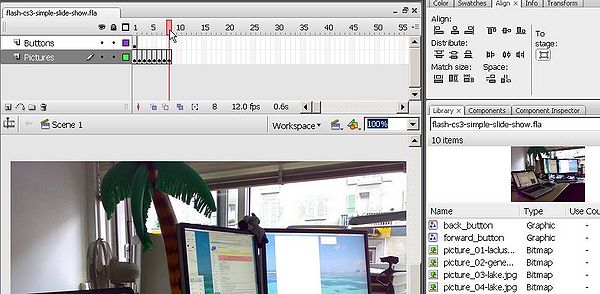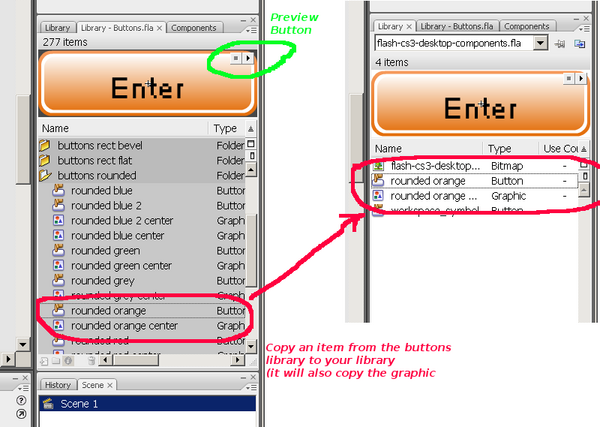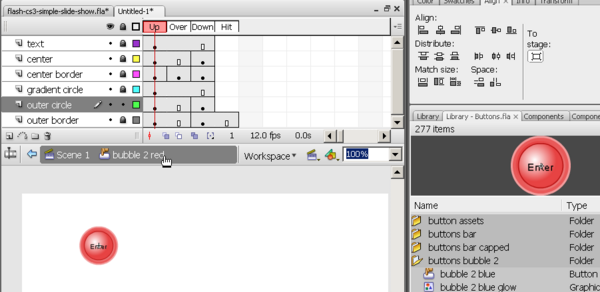Flash CS3 button tutorial: Difference between revisions
m (using an external editor) |
m (using an external editor) |
||
| Line 146: | Line 146: | ||
; Editing buttons | ; Editing buttons | ||
To customize a button symbol, double click on the icon of the symbol library panel. This will let you work just on this object, i.e. it puts you into a '''Symbol editing mode'''. There are other ways to get into this editing "inside" (via the general menu or double-click or right-click on an instance) | To customize a button symbol, double click on the icon of the symbol library panel. This will let you work just on this object, i.e. it puts you into a '''Symbol editing mode'''. There are other ways to get into this editing "inside" (via the general menu or double-click or right-click on an instance). You can for instance change the font or the color of a symbol or make changes to its frame-by-frame animations. | ||
You can for instance change the font or the color of a symbol or make changes to its frame-by-frame animations. | |||
; Finding your workspace again | ; Finding your workspace again | ||
| Line 161: | Line 159: | ||
; Editing the label of a button | ; Editing the label of a button | ||
A symbol is basically something that you can use several times over, but its fundamental look and feel properties will remain the same, including its the label. | A symbol is basically something that you can use several times over, but its fundamental look and feel properties will remain the same, including its the label. So if you need buttons with other labels you must create copies of these symbols. In your library panel right-click on the icon of the symbol and select ''duplicate'' from the popup menu. Choose an appriate name, e.g. "do not press" | ||
To change the label (and font) of a button: | |||
* Double click to get in the symbol editing mode. You will see a frame-by-frame animation movie (read the [[Flash frame-by-frame animation tutorial]] if you are not familiar with this). | |||
To change the label (and font) of a button | * Lock and hide all layers, except the layer with label (e.g. text). | ||
* Change it | |||
* You also can change font properties of course | |||
* Then you may have to adjust its position. Click on the select tool and move the text box with the cursors until it looks right (look at your library panel). | |||
[[image:flash-cs3-red-button-editing.png|thumb|600px|none|Symbol editing mode]] | |||
=== The four frames and the button layers === | === The four frames and the button layers === | ||
Revision as of 16:23, 1 September 2007
This article or section is currently under construction
In principle, someone is working on it and there should be a better version in a not so distant future.
If you want to modify this page, please discuss it with the person working on it (see the "history")
<pageby nominor="false" comments="false"/>
Overview
Buttons are interactive elements on which a use can click for example. This is part of Flash CS3 tutorials.
- Learning goals
- Learn how to create and use basic Flash 9 (CS3) buttons
- Learn a little bit of Action Script 2.0 to run somewhing with a button.
- Prerequisites
- Flash CS3 desktop tutorial
- Flash drawing tutorial
- Flash frame-by-frame animation tutorial
- Moving on
- The Flash article has a list of other tutorials.
- Quality
- This text should technical people get going and may not be good enough for self-learning beginners. It can be used as handout in a "hands-on" class. That is what Daniel K. Schneider made it for...
- Level
- It aims at beginners. More advanced features and tricks are not explained here.
- The executive summary - transform tools in the tools panel
Buttons are interface components to add simple interactivity, such as displaying extra information, launch a movie clip etc. To do so:
- Draw an object
- Attach some action script to it that will launch something
A simple slideshow with your own buttons
We will show how to create simple buttons with an example that demoes how to make a simple slide show. Purpose is to explain buttons, not to make the perfect slide show tool. First, we will import the pictures and adjust the stage. This we we can get a feel for the size of buttons needed.
- Step 0 - Open a new file
- Select ActionScript 2 (This code will not run with ActionScript 3.0 !).
- Step 1 - prepare some pictures
- Before importing the pictures, it's a good idea to make them all the same size, e.g. I made my pictures 640x480. If you work under windows, simply use the MS Office Picture manager...
- Then import these all to the library: Menu File->Import->Import to Library. Select all the pictures you would like to import, then click OK.
- Importing to libarary will turn them into symbols. That way we can later reuse them if we want to.
- Step 2 - Adjust the stage size
- Create a new layer, called "Pictures". In the first keyframe put some text, e.g. "Picture show" (you can fix this later)
- Create a new keyframe (frame 2)
- Drag a picture on the stage of frame 2, then make the stage as big (at least) as the picture. You also can make the stage a big bigger and then select for instance a black background
- To adjust the pictures, position use the properties panel below, i.e. set W and H to 0 (else use the alingn panel).
- Step 3 - Put your pictures into different keyframes
- If you have 8 pictures you need to add 7 new keyframes.
- On way to do this is to put your cursor in frame 2 of the picture layer, the hit F6 ("Insert new keyframe") 7 times
- Then drag a picture into each of these keyframes and align them too (as above).
- Control if all pictures are ok and in place by moving the playhead from left to right (red rectangle on top of the timeline)
So you should have something like this.
- Step 4 - Draw a forward, a home and a backward button
- Create a new layer and name it Buttons and select it.
- To draw buttons, you may use the Polystar tool for this and a variety of transform tools, or just simply draw a triangle and get done with it ...
- Then you also want to reduce the alpha channel (i.e. make these transparent). In the color panel, put Alpha to 40%.
- Once you got a forward button, make a copy and flip it horizontally (menu Modify->Transform->Flip Horizontal).
- Step 5 - convert these graphics into to symbols
- Save both buttons as button symbols (right-click on each graphic you made).
- Use decent names for these, e.g. "button_forward"
- Step 6 - place the buttons
- Select the Pictures layer
- Move both buttons to the stage in an a approriate position.
So now you should have something like 2 button symbols in the library and an instance of each on the stage.
- Step 7 - Add action script code ot the forward button
- Right-click on the button and select Action
- Insert this code:
on (click) {
if (this._currentframe == this._totalframes) {
gotoAndStop (1);
} else {
nextFrame ();
}
}
It should look like this: [[image:flash-cs3-button-button-action-script1.png|thumb|600px|none|Two button symbol instances on the stage]
- Step 8 - Add action script code to the backward button
- Right-click on the button and select Action
- Insert this code:
on (release) {
if (this._currentframe == 1) {
gotoAndStop (this._totalframes);
} else {
prevFrame ();
}
}
- Step 9 - Stop the movie in frame 1
- If you already tried to test the movie, you could see the frames displaying in rapid sucession. That's not what we want.
- Insert a new layer and call it "Actions".
- In frame one of this layer insert the following code in the Actions-Frame panel. If you can't see this panel, hit F9.
stop();
This some action script code that will stop the animation right after frame one is loaded. Only by clicking the buttons can the user then go forward or backward.
- Step 10 - Make sure you buttons are on stage for all frames
Finally, make sure that these buttons are displayed throughout the "movie"
- Select the buttons layer, click the last frame (where the last picture sits) and Right-click->Insert Frame. A the end you should see little white rectantangle.
Your timeline should roughly look like this:
- Step 11 - Tuning
You may want to fix the title page.
- Results
- You can look at my published result here
- You can grab all the files from this directory:
This slideshow was fairly simple. No picture animations, no fancy buttons, etc. Now you maybe would like to have more fancy buttons. We will not teach how to build them, but fortunately Flash CS3 has a whole lot in its library.
Overview of the built-in Flash button symbols
Flash contains a good variety of pre-built buttons. To use these, your first should dock the Library-Buttons.fla panel next to your libraries panel: Menu Window->Common Libraries->Buttons. (See the Flash CS3 desktop tutorial on how to dock a panel).
Buttons are arranged in folders, double click to open these. Then, you may may inspect various symbols by clicking a button. In the upper part of the panel you get a preview. Click on the arrow to see how it behaves.
For use in your own animation I suggest to copy a button first to your own libary. This way you can find the button again easily and you also can modify its features.
- Right-click on the Symbol and Copy
- Paste it to your own library. Open the library panel and hit crtl-V
From your library panel simply drag the button on the stage. This will create an instance of the button. To remove it from the stage, select it and hit the delete key. Make sure you operate with instances in your flash animation (not symbols themselves). If you did this right, you will see in the properties panel something like Instance of: rounded orange.
Customizing symbols and instances
- Editing buttons
To customize a button symbol, double click on the icon of the symbol library panel. This will let you work just on this object, i.e. it puts you into a Symbol editing mode. There are other ways to get into this editing "inside" (via the general menu or double-click or right-click on an instance). You can for instance change the font or the color of a symbol or make changes to its frame-by-frame animations.
- Finding your workspace again
There are several solutions:
- Select Edit->Edit Document (Ctrl-E).
- But I suggest to add the Edit bar: Window->Toolbars->Edit bar. It will show you exactly at what level you are editing, e.g. scene or button.
- You also may add the Scene Panel with Window->Other Panels; Scene (or hit Shift+F2).
As you can see in the picture below, on the Edit Bar from left to right you can see the cascade of editing levels. Right now we are editing the "bubble to red" button.
- Editing the label of a button
A symbol is basically something that you can use several times over, but its fundamental look and feel properties will remain the same, including its the label. So if you need buttons with other labels you must create copies of these symbols. In your library panel right-click on the icon of the symbol and select duplicate from the popup menu. Choose an appriate name, e.g. "do not press"
To change the label (and font) of a button:
- Double click to get in the symbol editing mode. You will see a frame-by-frame animation movie (read the Flash frame-by-frame animation tutorial if you are not familiar with this).
- Lock and hide all layers, except the layer with label (e.g. text).
- Change it
- You also can change font properties of course
- Then you may have to adjust its position. Click on the select tool and move the text box with the cursors until it looks right (look at your library panel).
The four frames and the button layers
Built-in button symbols contain four frames and several layers. For each frame, different drawings may be defined but some, e.g. the label text may be reused in several layers
To display frames and layers of a button, double-click on the button.
The four pre-defined frames used for buttons are:
- Up
The button, i.e. the drawing that appears "as is"
- Over
The button as it appears when the user moves the mouse over it. I.e. defines highlighting.
- Down
The button as it appears when the user presses the mouse (just during the time the mouse button is held). It makes the clicking effect
- Hit
This allows to define the sensible area (usually the complete button).
Various kinds of buttons have various layers (usually between three and five) depending on the complexity of the drawings. Beginners can just use one of these buttons. There is no need to change anything in the keyframes or the layers except the label.
Adding actions
So far, your buttons won't do anything useful. To support some user interaction, you have to learn a little bit of action script.
(to be written ...)
Links
Slide shows
If search the Internet you can find lots of Flash slide shows. Some commercial, some tutorials, some good, some outdated. Here are a few:
- Text tutorials
- http://www.toxiclab.org/tutorial.asp?ID=79
- http://maclab.guhsd.net/flash/mx/slideshow_01.html
- http://www.flashvault.net/tutorial.asp?ID=118
- http://www.lukamaras.com/tutorials/actionscript/ultimate-dynamic-image-gallery.html (advanced)
- Video tutorials
- Creating slideshows in Flash CS3 by Craig Campbell. The basic version is free.
- examples
- Slideshowpro (commercial kit)





